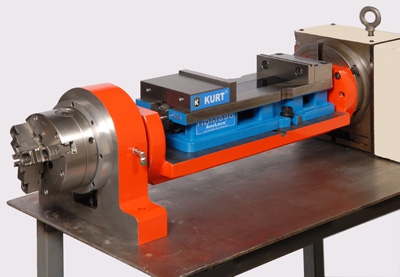
The new Stallion Hybrid trunnions from TrunnionTable.com allow faceplates and chucks to be installed without removal of the trunnion table for faster part setups, increased productivity and higher quality parts. The versatile workholding workhorses accommodate a variety of vises, fixtures, 3- and 4-jaw chucks and collet chucks for flexible job shop workholding. Two models are available, the Stallion Hybrid 9/20 (9" x 20") designed to hold a 6-in. vise and the 9/23 (9" x 23") designed for double or single station 6-in. vises. Both sub-plates and quick-change sub-plates are available with quick-change ballocks.
Standard baseplates allow the trunnion assembly to be offset to one side of the machine to maximize machine travel. A pneumatic brake, built into the outboard support, provides up to 600 lbs. of clamping torque, an invaluable feature for shops doing heavy off-center milling and drilling. Hydraulic work-holding packages are also available.
"These fixtures are designed for job shops looking to reduce setups and boost 4-axis machining productivity," said Stan Martin, president of TrunnionTable.com. "One customer went from 11 setups on five machines down to six setups on one machine just by adding the hybrid trunnion. It save them between $50,000 and $60,000 on that job alone."
The U.S.-made trunnions are engineered to bolt on to any machine's rotary indexer, allowing operators to precisely mill, drill, tap and contour up to three sides of a part in one setup. Heavily ribbed cast iron construction provides high rigidity and durability, needed to withstand long-term repeated use in demanding shop environments.
Contact Details
Related Glossary Terms
- collet
collet
Flexible-sided device that secures a tool or workpiece. Similar in function to a chuck, but can accommodate only a narrow size range. Typically provides greater gripping force and precision than a chuck. See chuck.
- gang cutting ( milling)
gang cutting ( milling)
Machining with several cutters mounted on a single arbor, generally for simultaneous cutting.
- milling
milling
Machining operation in which metal or other material is removed by applying power to a rotating cutter. In vertical milling, the cutting tool is mounted vertically on the spindle. In horizontal milling, the cutting tool is mounted horizontally, either directly on the spindle or on an arbor. Horizontal milling is further broken down into conventional milling, where the cutter rotates opposite the direction of feed, or “up” into the workpiece; and climb milling, where the cutter rotates in the direction of feed, or “down” into the workpiece. Milling operations include plane or surface milling, endmilling, facemilling, angle milling, form milling and profiling.
- milling machine ( mill)
milling machine ( mill)
Runs endmills and arbor-mounted milling cutters. Features include a head with a spindle that drives the cutters; a column, knee and table that provide motion in the three Cartesian axes; and a base that supports the components and houses the cutting-fluid pump and reservoir. The work is mounted on the table and fed into the rotating cutter or endmill to accomplish the milling steps; vertical milling machines also feed endmills into the work by means of a spindle-mounted quill. Models range from small manual machines to big bed-type and duplex mills. All take one of three basic forms: vertical, horizontal or convertible horizontal/vertical. Vertical machines may be knee-type (the table is mounted on a knee that can be elevated) or bed-type (the table is securely supported and only moves horizontally). In general, horizontal machines are bigger and more powerful, while vertical machines are lighter but more versatile and easier to set up and operate.
- tap
tap
Cylindrical tool that cuts internal threads and has flutes to remove chips and carry tapping fluid to the point of cut. Normally used on a drill press or tapping machine but also may be operated manually. See tapping.






